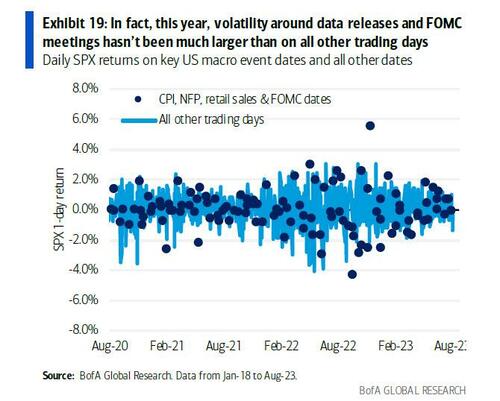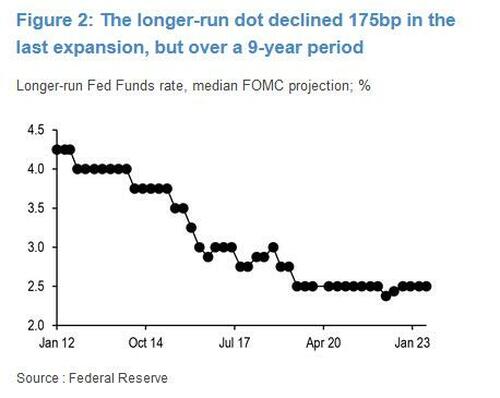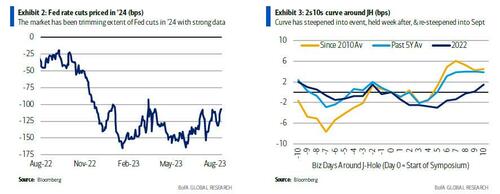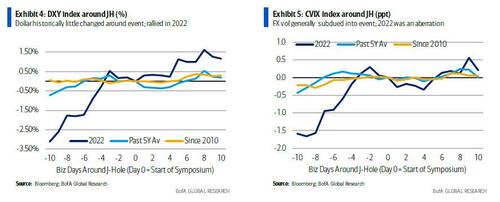Jackson Hole Preview: “Do We Receive Another Hawkish Surprise?”
With the most important earning report of the week, and probably quarter, out of the way, when NVDA reported blowout earnings and guidance only to see a bout of selling the news which nearly pushed the stock to red on the day, because as JPM’s Stuart Humphrey said “now we can be happ… until we get pessimistic into the next earnings print because THERE IS NO WAY THEY CAN GUIDE LIKE THIS AGAIN….or can they“, attention now turns to the last main event of August, and the summer, when Jerome Powell speaks tomorrow just after 10am ET, at Jackson Hole.
Before we go deeper, here is quick FAQ courtesy of BofA economist Aditya Bhave:
- When is it & what is topic? August24-26, “Structural Shifts in the Global Economy”
- Why does market care? Fed Chairs often speak, and other officials attend. Major policy changes have been signaled, and it is often during a long intermeeting period.
- What do we expect at JH? Fed to reiterate 2% objective, stress more inflation work to do, sound less balanced vs July presser or FOMC minutes due to recent strong data.
- What is market JH reaction? Rates = less balanced Fed guidance will be hawkish; stay underweight front end. FX = no strong signal likely, neutral rate focus likely hawkish.
- What is historic JH reaction? Rates = sell off into JH, sideways week after, sell off into Sept; curve flatter (Exhibit 1); FX = sideways, 2022 was outlier
With memories still fresh how Powell crushed markets exactly one year ago, when his last-minute revised, and at just 8 minutes, sharply abbreviated speech sent stocks tumbling more than 3% and accelerated the global bear market, while the prevailing rhetorical question is “do we receive another hawkish surprise”, the consensus view around Powell is that this time we will receive no new information, because, as JPM’s Market Intel desk writes, “the Fed is strictly data dependent, and that all pause will be characterized as a “hawkish skip” to maintain optionality.“
Of course, blindly hoping that Powell will not rock the boat may be the fastest way to being stopped out of a career in finance, as today’s post-Nvidia reversal selloff in both bonds and stocks demonstrates, as markets start to freak out about the return of a much more hawkish Powell.
That’s why we previously published not one but two J-Hole previews: in the first one we analyzed what the Fed chair may say…
Powell will i) present a modestly hawkish medium-term baseline policy stance, ii) allow for risk that the Fed is done hiking but not shut down the possibility of more tightening, iii) while damping expectations of early cuts.
Powell may also raise the prospect of future pre-emptive strikes to limit inflation surges, arguing that the difficulty in slowing inflation and its disproportionate impact on low-income families justify an asymmetric policy.
Market-moving comments would likely relate to the rising term premium at the long end in fixed-income markets and any indication whether the Fed sees it as either desirable or likely to persist. The Fed doesn’t control long-term rates actively, despite buying and selling for the Federal Reserve System portfolio.
… and the second one warned that “Equities Are At Greater Risk Of Jackson Hole Shock Than Is Priced In“, and which looked at the market’s growing complacency as volatility on major macro “events” and releases has been surprisingly muted vs other trading days unlike previous years.
While we urge readers to refresh on both of the above notes, we wanted to point out that JPM’s rates strategist Jay Barry did a good job breaking down recent Treasury behavior and what is likely on/off the table to be discussed by Powell. For the TL/DR crowd, JPM’s conclusion is that with the 10Y around 4.25%, yields are likely too high, and Jackson Hole could be the catalyst for a near-term rally, which would aid risk-assets. Some more details from Barry’s note below:
To the extent that the title of this year’s conference is “Structural Shifts in the Global Economy” and that Chair Powell pushed back against market pricing in a more hawkish fashion in this venue last year, market participants have been speculating about whether this year’s edition will be another market-moving event. Indeed, a well-respected Fed reporter over the weekend wrote on how stronger productivity gains and a wider budget deficit might raise the neutral interest rate , (r*).
“Conceptually, if the economy is running above potential at 5.25% interest rates, then that suggests to me that the neutral rate might be higher than we’ve thought.” https://t.co/IUr8x6zpmN pic.twitter.com/hdpVnWXrcy
— Nick Timiraos (@NickTimiraos) August 20, 2023
Indeed our own economics team argued earlier this year that low neutral rate estimates are a result of GFC reverberations which depressed demand and inflation, and that the cyclical backdrop points towards higher neutral rates. Moreover, resilience in the face of a large policy shift would reinforce the case for revising neutral higher (see When you wish upon r*, Bruce Kasman, 2/15/23). Notably, individual FOMC estimates of the longer-run Fed funds rate, which markets view as a proxy for r*, have been gradually moving up in recent SEP, but have yet to affect the median rate. While the article made the case on why the neutral rate of interest might be rising, the article concluded by saying Fed leadership had not yet been convinced about this. Nonetheless, in an environment in which long-term yields have been climbing for the last month driven by increased growth and inflation expectations, and perhaps exaggerated by a less supportive monetary policy backdrop globally and fears of increased duration supply, this has only added pressure to yields ahead of Chair Powell’s comments at Jackson Hole on Friday morning. We think it’s somewhat unlikely the Chair’s comments will foreshadow a larger change to the longer-run dot at the September FOMC meeting, as Chair Powell has repeatedly discussed policy as being restrictive. Moreover, if history is a guide, this could be a slow process: Figure 2 shows the median longer-run dot declined 175bp over the last expansion, but this was spread over a decade. Thus, we think it would be difficult to conclude with certainty the Chair would make an aggressive statement on this topic on Friday, even though the risk may lean in this direction.
Another way of putting this: the Fed is increasingly contemplating how to break it to the public that it will have to raise the inflation target from 2% to 3%, something we said over a year ago is coming…
My latest @WSJopinion advocates a hawkish pivot to a higher inflation target.
A higher target has many benefits but would be terrible if it deanchored expectations.
The better the Fed can do now on inflation the more room it will have to adjust long run. https://t.co/nDe5313Bg8
— Jason Furman (@jasonfurman) August 20, 2023
… and which a Jason Furman weekend op-ed reinforced.
My latest @WSJopinion advocates a hawkish pivot to a higher inflation target.
A higher target has many benefits but would be terrible if it deanchored expectations.
The better the Fed can do now on inflation the more room it will have to adjust long run. https://t.co/nDe5313Bg8
— Jason Furman (@jasonfurman) August 20, 2023
What about JPM’s trading desk? Here, we look to the latest note from Market Intel head Andrew Tyler who reminds us of what he wrote after the latest CPI release: “The CPI, hourly earnings, and jobless claims combined to create a dovish signal for the markets. The disinflation story continues but this print is not enough to remove the ambiguity surrounding the Fed’s future behavior meaning we are likely to get a data-dependent message at Jackson Hole before seeing a “hawkish skip” at the Sept meeting. While today sets up as a relief rally of sorts, I do not think this is a dovish enough print to push markets back to near-term highs given the dearth of market-moving information and the seasonal weakness of Aug/Sept. That said, I do think Q4 will be a strong quarter for stocks as the economy continues to exhibit growth without inflation and the prospect of improving earnings and lower yields will also be positive for indices.”
As Tyler concludes, while there has not been enough of break in macro data to warrant a change in this view, given the market turmoil surrounding China, let’s see if Powell addresses potential risks or look at the recent surge in yields as additive to their mission, or say nothing.
* * *
Turning to Bank of America’s view, here is what the bank expects from Fed communications?
We expect Powell to reiterate the Fed’s commitment to its 2 percent inflation target. He will likely note that although there has been progress on the inflation front, there is still a lot more work to be done. Therefore, policy will remain restrictive for an extended period.
At the July press conference, Powell noted that risks around the impact of Fed policy were becoming more balanced and, given the lagged effect of monetary policy on the economy, the Fed would likely start cutting rates before inflation reaches 2%. We think the tone could be less balanced at Jackson Hole given the robust data flow since the July FOMC meeting. In particular, 2Q GDP came in well above expectations at 2.4%, and July retail sales ex-autos surged by 1.0%. While the Fed would prefer not to short-circuit the business cycle, policymakers are probably becoming increasingly concerned about a re-acceleration in inflation, driven by strong aggregate demand. Therefore, we expect Powell to push back— implicitly or explicitly— against the degree of rate hikes that markets are pricing for next year.
Meanwhile, in terms of the extent and timing of additional hikes, Powell is likely to emphasize that the Fed is data-dependent and every meeting is live. If Powell were to comment that he is comfortable with the current pace of hikes for now, markets would view that as guidance towards a pause in September and a possible hike in November.
Market participants have recently speculated that Jackson Hole will be used as a venue to highlight upcoming shifts in Fed communication around the neutral rate. Market focus has recently increased on the neutral rate due to underlying economic resilience in the face of elevated policy rates & re-pricing of global 3y1y rates.
We would be surprised to see any large shift in Fed communications around the neutral rate at Jackson Hole, given that there is significant uncertainty around estimates of this rate. If the Fed were to signal expectations for a higher neutral rate it would likely be interpreted by the market as hawkish since it implies higher overnight rates to slow the economy.
Next, BofA looks at what is expected rates & FX market reaction around Jackson Hole?
US rates: Fed communications that sound less balanced vs the July FOMC minutes risk being interpreted as hawkish by the market. This could result in greater pricing of hikes at the Sept & Nov meetings, which cumulatively price 11.5bps of further tightening. We would not be surprised to see this pricing shift to 15bps if more balanced Fed rhetoric is adjusted due to recent strong data in favor of a clearer tightening bias.
Hawkish Fed rhetoric risks & increased hikes will reinforce our core view for clients to remain underweight the UST front end. We have recommended clients position in Dec ’23 – Mar ’24 FOMC steepeners, which should benefit from a more hawkish Fed message and / or reiteration of higher for longer message. We also expect a further reduction in the extent of rate cuts priced in ’24. Cuts in ’24 have been reduced by 25bps since last Monday; we see risks these cuts are reduced further (Exhibit 2). A further reduction of rate cuts will likely result in a bear flattening of the UST curve.
FX: This year’s Jackson Hole conference occurs amid a relatively choppy and rangy FX market. The dollar has been rallying over the past month mainly on relative U.S. growth outperformance and the rise in both nominal and real yields. (FX Watch: The USD’s road trip 16 August 2023) However, this has been occurring amid a broader disinflationary trend in the U.S., as well as expectations that several other major central banks could keep rates higher-for-longer than the Fed to bring core inflation down. While we do not anticipate any overtly strong policy signals from Jackson Hole this year (as noted above), any overt suggestion of a higher-than-expected neutral policy rate could serve as a fresh catalyst for another leg of dollar appreciation. Conversely, should the topic of eventual rate cuts receive prominence, the dollar could move back into the lower-half of the year’s range.
Finally, what are the historic rates & FX reaction around Jackson Hole?
Rates: US rates have recently sold off into Jackson Hole, held the moves during the week after, and sold off more meaningfully into September. Since 2010 the US 10Y has declined 2+bps in the symposium aftermath but increased 3+bps in the 10D after. Over recent years the yield declines have been smaller & sell-off larger. The largest sell-off in recent years was 2022 due to Powell’s hawkish remarks on inflation.
The UST curve has tended to flatten modestly in immediate response to Jackson Hole (Exhibit 3). However, the curve has historically steepened in the 10D after the event. Powell’s 2022 Jackson Hole speech resulted in a curve steepening in the 10D after the event despite the more hawkish message & large rate sell-off at the front end.
Overall, recent years have seen the UST curve bear steepen in response to Jackson Hole.
FX: The dollar has traded within a modest +/- 0.5% range in the 10 days before and after Jackson Hole on average (Exhibit 4). FX volatility has similarly been subdued around the event (Exhibit 5). However, 2022 was a bit of an aberration. Last year, the USD appreciated about 3% in the 2 weeks leading up to Jackson Hole and continued another 1% in the weeks after.
While Chair Powell’s hawkish remarks added to the dollar’s ascent in 2022, it’s uptrend was well entrenched prior to the event. Indeed, 2022 was a noteworthy year for the dollar, as the DXY index reached a new 20-year high that September. Drivers for the dollar’s appreciation at the time included: the Fed’s aggressive tightening campaign, recession fears across the globe, energy shocks in Europe and elsewhere, and China’s zero-covid policies.
Turning to equities, it’s worth noting that while stocks usually move up by 40 bps in the following week, investors vividly recall the -3.2% move after last year’s hawkish surprise. This year, with 3 of 4 financial stability indicators having deteriorated from “moderate” levels, JPM’s trading desk writes that we may see a more neutral Powell allowing for another week of calm before we kick off the quarter’s finishing kick post-Labor Day.
Goldman had a preview note too, and we summarize the key parts below:
Q: What do we expect policymakers’ message to be?
A: We are not expecting to get a strong monetary policy signal out of Jackson Hole. Although we do expect the FOMC to skip a hike in September, key data including the PCE inflation and employment data come out shortly after the Jackson Hole symposium. The Fed will likely wait to be informed by these new data before changing their current posture.
We expect Powell’s speech will touch on similar themes to last year’s. Bringing inflation back down to target remains the Fed’s key concern, though the current backdrop is much more reassuring. Last year, the Fed was on the verge of making a big upward revision to both its inflation and unemployment rate forecasts; Powell warned that reducing inflation would ‘bring some pain’ – a statement that induced a significant market correction. This time around, a soft landing looks more plausible than at any point over the last year, and we expect that Powell’s message will be that they’re going to see the job through.
We also expect the sideline interviews to be close to what we have been hearing over the past few weeks – adamant that they will ‘see the job through’, but no rush to hike again either. We suspect the debate will turn to whether the Fed should turn to a ‘higher for longer’ policy or will follow New York Fed President Williams on the idea that they might need to cut to keep the real funds rate from rising too much.
Given the conference topic, President Lagarde’s speech could touch on some of the same topics she spoke about earlier at the Council on Foreign Relations. She argued that a more fragmented economy could lead to more instability and less resilient supply chains. Her speech at Sintra argued that there was a risk of more persistent inflation risks, and that monetary policy should break this chain by holding down demand. That is a very different type of inflation persistence than the ECB had to combat for most of the last decade, so this could also fit the theme of the Jackson Hole symposium, to some extent.
Q: What is the conference topic and how does that dictate the discussion?
A: This year’s conference topic is “Structural Shifts in the Global Economy,” which will set the direction for the research that gets presented, but much less so for the sideline interviews.
Although the conference organizers have not yet given any guidance as to what the discussions will cover, a few possible topics include deglobalization and the green transition, the neutral rate, artificial intelligence, larger fiscal deficits, and remote work. We will be watching particularly closely for any discussion of the neutral rate.
Typically, the conference topic will feature prominently in the keynote address (though it does not preclude a separate policy discussion) and dictate the papers being presented. While the academic part of the symposium has the potential to impact the long-run direction of policy, the side interviews should shed more light on immediate policy questions. And we should note that this particular conference is one of many such events held throughout the year, with no particular extra relevance in this regard.
* * *
Still not enough? We conclude with some excerpts from the just published J-Hole preview from Fed whisperer Nick Timiraos:
- As with previous years, Powell is unlikely to use his speech to preview the Fed’s very near-term policy deliberations. Rather, he is more likely to review what the central bank has done and provide a broader framing of where policy might be headed. Such remarks would likely underscore that the Fed’s inflation-fighting job isn’t done.
- “The theme I would be emphasizing is trying to get people off the binary view that once inflation starts coming down, it’s mission accomplished,” said former Fed Vice Chair Richard Clarida, who served with Powell from 2018 until early 2022. “What they want to avoid is” declaring an end to rate rises “and then find themselves next spring with underlying inflation not really having edged down in a very tight labor market.”
- It may be too soon for Powell to publicly discuss how Fed officials might manage the proverbial last mile of the inflation fight—in which inflation gets much closer but not all the way to their 2% target. But the issue is likely to be a topic for lively debate on the sidelines of the conference.
- “It’s too early to declare victory. It’s too early to foreclose the possibility of another hike down the road,” said Ellen Meade, an economist at Duke University who is a former senior adviser at the Fed. “Powell will need at some point to talk about that last mile, but right now he’s navigating the end of tightening and the how-long-to-hold conversation. The last mile comes after that.”
- The theme of this year’s conference, “Structural Shifts in the Global Economy,” will delve into whether and how the Covid pandemic and the policy response permanently altered the economy, including trade networks and global financial flows. Papers will examine the potential ramifications of rapid shifts in monetary policy and the large increases in public debt. Christine Lagarde, president of the European Central Bank, is set to speak Friday at 3 p.m. ET.
- One overarching question is whether the economy is exiting a period of low inflation and low interest rates that occurred between the 2008 financial crisis and the 2020 pandemic, and which some economists then dubbed the “new normal.” Policy makers concluded over the past decade that the neutral rate of interest, or the level that should prevail when the economy is growing steadily with low inflation, had declined.
- Clarida said he expects the neutral rate will return to the lower levels that likely existed before the pandemic, even if Treasury yields remain modestly higher because of the premium investors demand on longer-term debt.
More available to pro subs in the usual place.
Tyler Durden
Thu, 08/24/2023 – 14:40
via ZeroHedge News https://ift.tt/S9JbFM6 Tyler Durden




